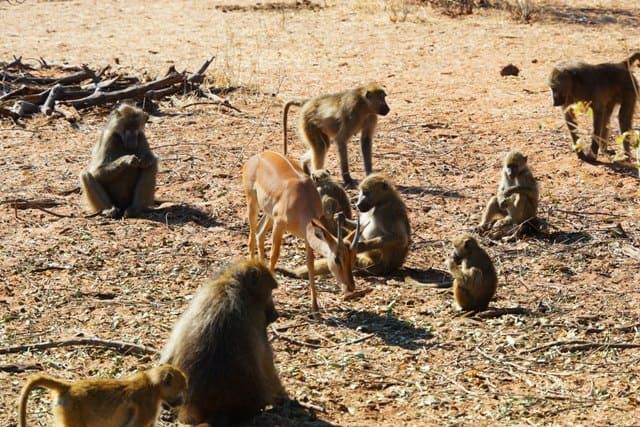Kruger National Park
Just like us, the extraordinary wildlife of the Kruger National Park gets by with a little help from their friends! Home to 2,000 plant species, 500 different birds, and 147 species of mammals including the world-famous ‘Big 5’, the Kruger is home to a myriad of symbiotic relationships. With no shortage of incredible wildlife wonders to see, there’s a reason why the Kruger is South Africa’s most celebrated safari destination. As we approach International Friendship Day, on 30 July, forget Pumbaa and Timon and behold some of the unique and essential animal relationships of the park’s lively ecosystems.
The indispensable and popular oxpecker
Oxpeckers are known to have a few astounding symbiotic relationships within the Kruger. These small parasitic birds form remarkable bonds with elephants, impalas, and rhinos. The cheeky red-beaked oxpeckers, named askari wa kifaru (the rhino’s guard) in Swahili, perch themselves on their mammal friends to feast on a buffet of ticks and parasites.
“Across picturesque open grasslands, woodlands, and riverine visitors can marvel at seeing the loud oxpecker’s grooming service in action – they’re like the animal spa therapists of the Kruger,” says Enock Mkansi, a safari guide at Kruger Gate Hotel.

The duty of the oxpecker doesn’t stop with ridding their friends of pests, these avian custodians are also especially helpful as unlikely security guards. Astonishingly, research by Roan Plotz of Victoria University in Australia has revealed that the non-vocal black rhinos can evade human detection with the help of oxpeckers in up to 50% of encounters. Researchers found that oxpeckers improved the rhinos’ human detection distance by nine meters, signaling that integrating more of these versatile birds with rhino populations could assist in a broader rhino safety approach.
It’s remarkable how oxpeckers act as an alarm system for impalas and rhinos. It’s a spellbinding sensation when you hear these birds let out a loud screech on top of rhinos to warn of oncoming danger. Rhinos have weaker eyesight, and as such rely on other senses to stay safe, so once they hear this unmissable alert they know to get a move on and they almost always do.
“Symbiotic animal relationships are about the various ways that different species interact with each other in the same environment, and it’s specifically interesting to see how different species can help each other,” explains Mkansi.
A blended crowd
Within the tranquil Greater Kruger Conservancy, situated on the banks of the breathtaking Sabie River, the Kruger Gate Hotel is an idyllic setting to witness the integration of zebras and wildebeest. The two herbivorous grazers are known to band together and assemble hybrid herds. What makes the various symbiotic pairings in the Kruger brilliant is that these majestic animal friends make up for each other’s shortcomings.
“In this special alliance, the Kruger’s striking zebras are blessed with a sophisticated sense of sight, whereas their brawny wildebeest allies are gifted with superior hearing. The merging of these vital qualities safeguards the fused herds from predators and peril. Additionally, these brilliant animals make the perfect symbiotic pair at mealtime. During their joint grass dining in the enchanting Kruger bushveld, zebras eat the elevated grass first, with wildebeests relishing the shorter grass they leave behind,” Mkansi details.
Foraging friends
Along the sublime acacia country water holes of Lower Sabie, the Kruger National Park’s most common antelope, impalas, gather for short grass, a steady stream of water, and the chance to dine on the delicacy of sausage fruit. Just like their name suggests the sausage fruit is an elongated, thick-skinned, sausage-like berry that hangs from the sausage tree, and these agile ungulates are unable to reach for and eat the fruit on their own. Whilst you might be put off by your friend’s leftovers, impalas have no problem dining on the sausage fruit scraps of their baboon pals, because they can’t chew through the fruit’s tough skin on their own.
Impalas and baboons can be seen clustered together throughout the unspoiled wild Kruger terrain, and their relationship extends beyond nourishment needs. Their behavior suggests that impalas could even feel safer around the chacma baboons! The park’s impalas spend far less time assessing their surroundings for danger, as they can identify their baboon companion’s calls signaling a predator.
Beyond the Kruger
Further afield there are many other exciting animal relationships across the African continent. Researchers in Uganda have noted that, just like the oxpecker, mongooses have been known to rid warthogs of unwanted pests. Interestingly the warthogs act like clients to their mongoose friends, as they are known to approach the mongooses for a cleaning session. The pair have been observed with the warthogs lying down as mongooses scamper over them to eliminate ticks and parasites.
“Year-round thousands of visitors enjoy all sightings of breathtaking African wildlife, and we are incredibly excited to witness these intricate bonds and alluring creatures on South African soil, right in the heart of the Kruger,” Mkansi concludes.





